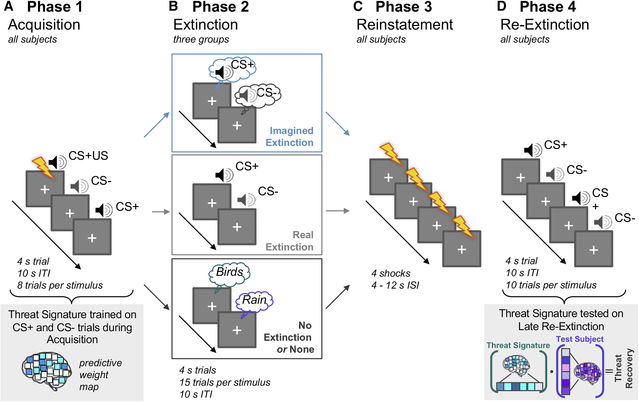Fear
How Vivid Imagination Can Help People Unlearn Fear
Imagination can create a neurological reality that helps the brain unlearn fear.
Posted December 13, 2018

Crippling fear undermines the day-to-day quality of life for countless individuals around the globe. It’s estimated that about a third of people in the United States have had a threat-related anxiety disorder or phobia. Approximately 7 percent of people living in the U.S. are thought to have had post-traumatic stress disorder at some point.
Since the 1950s, the most common threat-extinction tool for “extinguishing” someone’s fear of a specific stimulus (e.g., spiders, elevators, airplane travel) has been a method called “exposure therapy.”
During exposure therapy, someone with crippling fear is repeatedly exposed to his or her real-world threat in manageable doses while a professional clinician literally or figuratively holds the person’s hand throughout the process. Over time, as the mind and body realize that the threat is harmless, the brain slowly begins to unlearn fear. The autonomic nervous system is also re-conditioned to stay calm in these situations, so there isn't an automatic fight-or-flight stress response when exposed to the “threatening” stimulus.
For obvious reasons, exposure therapy can sometimes be impractical or costly (e.g., expense of air travel). Unfortunately, there are few clinically tested alternatives for unlearning fear. But there is new hope on the horizon for those who suffer from threat-related disorders.
New research from the Wager Lab at the University of Colorado Boulder demonstrates how imagination can be an effective tool for simulating re-exposure to threat in a way that ultimately mitigates the threat response. This study, “Attenuating Neural Threat Expression with Imagination,” was recently published in the journal Neuron.

As the authors explain, “This investigation demonstrates the utility of imagination as a threat-extinction tool and proposes a neural mechanism for imagined extinction that includes a network of brain regions known to support the real extinction learning. These findings expand our understanding of how the human brain modifies threat representations and, in turn, our ability to treat threat-related disorders using mental action.”
For this study, lead author Marianne Cumella Reddan and colleagues used fMRI brain imaging to investigate how, after a threat response was conditioned under real-world circumstances, imagined exposure to the threatening stimulus could influence the neural and physiological response to the stimulus. “These novel findings bridge a long-standing gap between clinical practice and cognitive neuroscience. This is the first neuroscience study to show that imagining a threat can actually alter the way it is represented in the brain,” Reddan said in a statement.
Regarding the neural mechanisms behind unlearning fear using imagination, the authors explain, “Like real extinction, imagined extinction engages the ventromedial prefrontal cortex, amygdala, and related perceptual cortices. Nucleus accumbens activity predicts an individual’s ability to successfully extinguish via imagination.”
As seen in the graphic below, for this study, Reddan et al. developed a novel whole-brain fMRI predictive pattern to test how effectively imagined extinction reduces threat responses in the brain.

The authors sum up their findings: "We found that imagined and real extinction are equally effective in the reduction of threat-related neural patterns and physiological responses elicited upon re-exposure to real-world threatening cues."
This research suggests that imagination may be a more effective threat-extinction tool for unlearning fear than we’ve understood until now. “If you have a memory that is no longer useful for you or is crippling you, you can use imagination to tap into it, change it and re-consolidate it, updating the way you think about and experience something,” Reddan concluded.
The researchers note that this study has some limitations. Also, more research is needed to identify best practices for making imagination universally effective. For example, individuals who inherently have a more active and vivid imagination are prone to experience greater brain changes when visualizing a perceived threat in the mind’s eye. For now, co-senior author of this paper, Tor Wager, advises that each of us should pay closer attention to how we use imagination: “You can use imagination constructively to shape what your brain learns from experience.”
References
Marianne Cumella Reddan, Tor Dessart Wager, and Daniela Schiller. "Attenuating Neural Threat Expression with Imagination." Neuron (First published: November 21, 2018) DOI: 10.1016/j.neuron.2018.10.047


